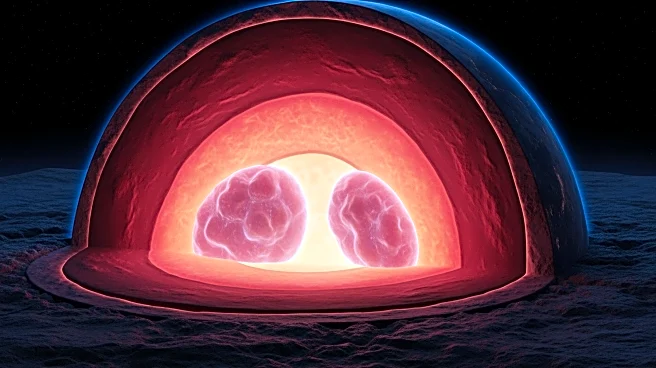What's Happening?
Researchers have developed new models to explain the origins of two dense, giant blobs located above Earth's core, known as large low-shear-velocity provinces (LLSVPs). These structures, discovered in the 1980s
through seismic data, are situated under Africa and the Pacific Ocean. The blobs are characterized by their distinct composition, which affects the speed of seismic waves passing through them. Previous theories suggested they might be remnants of old tectonic slabs, a cooling magma ocean, or debris from a celestial collision. However, recent studies propose that these blobs may have formed from material leaking from Earth's core during its early formation, mixing with the mantle. This theory aligns with the presence of ultra-low velocity zones (ULVZs) at the core-mantle boundary, which are associated with the LLSVPs.
Why It's Important?
Understanding the origins and composition of these blobs is crucial for insights into Earth's formation and its current geological behavior. The African blob, in particular, has been linked to a weakening of Earth's magnetic field over the Atlantic Ocean. The study of these structures could reveal their role in the formation of tectonic plates, which are essential for Earth's habitability. The findings suggest that the blobs have persisted over billions of years, potentially influencing the planet's geological evolution. This research not only enhances our understanding of Earth's history but also provides a framework for studying other planets' geological processes, offering clues about their evolution and habitability.
What's Next?
Further research is needed to validate the new models and explore the implications of these findings on Earth's geological history. Scientists may conduct additional simulations and gather more seismic data to refine their understanding of the blobs' composition and behavior. The study could prompt a reevaluation of existing theories about Earth's early history and its tectonic activity. As researchers continue to investigate, they may uncover more about the role these structures play in Earth's magnetic field and tectonic dynamics, potentially leading to new insights into planetary science.
Beyond the Headlines
The study of these giant blobs touches on broader themes of planetary science and the search for life beyond Earth. By understanding the conditions that made Earth habitable, scientists can better assess the potential for life on other planets. The research also highlights the complexity of Earth's interior and the intricate processes that have shaped its evolution. As scientists piece together the planet's history, they contribute to a deeper understanding of the factors that make Earth unique in the solar system.














